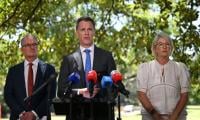Just as the year 2022 came to an end, some 20 kms from Sanghar, Sindh, a badly mutilated and raped woman’s body lay in mustard fields. She was found by her son after having gone missing from her home, where she had left hours earlier, to what they presumed was to pick grass. Her name was Daya Bheel. She was decapitated and her breasts and other organs cut off. Her skin and hair removed. A corpse, most likely unrecognizable, by the time she was found.
These gruesome details aren’t being given to make the reader feel more helpless. They are being told in the hope that we question the system and the authorities on present-day femicide, lawmakers come out of slumber, the judiciary has a theoretical shift when dealing with cases of violence against women and girls and law enforcement respond without requiring social media to make them do their job.
An official committee has been formed in Sindh to investigate the murder, under the supervision of the highest political leaders in the province. Some arrests have been made and the investigation it seems is making process. But will this investigation and its findings bring any change to the lives of poor, religious minority women in the country? Will it influence federal and provincial governments’ policies towards addressing violence against women? Will it influence policy on how to prevent violence, by educating men? The real question is: will Daya Bheel’s killing be the tipping point we need?
In terms of hard data, according to the Pakistan Demographic Health Survey (PDHS), 2018, 28 per cent of women and girls between the ages of 15 and 49 experience some form of violence. It is widely accepted that these figures are only the tip of the iceberg, with many cases of violence unreported. There is also no disaggregated data on violence against minority women. We are, therefore, not fully aware of the extent of the problem. The forms of violence, that minority women and girls face, and we have some figures on, are forced abduction, conversion and marriage.
According to the Centre for Social Justice, in 2022 alone, there were a total of 46 abductions and forced conversions of minor girls. These include 33 in Sindh, 12 in Punjab and 1 in Khyber Pakhtunkhwa. These incidents have increased. Between 2013 and 2020, there were approximately 162 incidents of forced conversion. In 2022, a 15-year-old, Pooja Oad, was shot in Rohri, Sukkur during an abduction attempt. Though penalizing forced marriage law has been unsuccessful in the Sindh Assembly, provincial and federal governments have been proactive in passing other pro-women penal offences. But the lack of awareness of the law, widespread societal acceptance of violence, ineffective rules and protocols, almost non-existent medico-legal and law enforcement accountability and judicial inconsistency when giving judgements are just some of the reasons for the lack of implementation of these laws.
All political parties have, to varying degrees, made manifesto pledges towards protecting and enhancing women and minority rights. All political parties have also failed in fulfilling these pledges. They are gripped by their own political uncertainties and consistently lack vision on how to improve people’s lives. But most terrifying is the grip that organized religious extremist groups, often responsible for organized abduction and forced conversion of young girls, have over politicians and the political process when it comes to dealing with these issues. Law and policymakers and law enforcement, it seems, conclude that it is easier to proactively deal with individual cases of violence, and only those that reach media attention, then addressing the widespread and structural problem of violence against religious minorities.
Daya Bheel was a victim to sorcery. The authorities are quick to say it was not a hate motivated crime; not a crime against a Hindu because of her religion. Yet she was poor, Sindhi and Hindu. A widow in her 40s. These are all political and socio-economic identities that disadvantage one in Pakistan. The combination of her socio-economic status and her murder not linked to a hate crime may, subconsciously, blunt the anger we feel, create a justification to be less outraged. After all, we have become immune to women being killed by an angry partner or a violent husband. Instead, society has reverted to asking questions of helpless victims, even dead ones, instead of questioning the accused and the system that allows total immunity.
We asked why Noor was in the company of a man she was not married to. We asked why Sarah Inam continued to stay in the room while her husband became violent. Questions like these may not be outright support for the violence that occurs but they are small justifications for each crime, drawing attention away from the criminal act and the preparator. Perhaps outright commendation without questioning the victim’s behaviour is not something that comes naturally in a society that blames women for violations, regardless of the facts. We forget, or don’t know, that issues of violence are systemic, widespread and firmly rooted in misogyny.
In the case of Daya Bheel, how will we justify it? Just a poor woman’s fate? A personal matter of magic and witchcraft of which there is no question of more sinister intentions? A community’s own internal conflicts? Already, social media outrage has been muted on the incident, and no consistent protests have taken place outside press clubs like in other cases of violence against (urban) women. Perhaps the fate of poor people is not what outrages social media users and middle class sensibilities.
Concepts of femicide, the killing of women because of their gender, are things that we discuss when middle-class women that we can relate to are killed. Perhaps because the killers are also entitled middle-class men, who we feel must be held to account. Whereas in the case of Daya Bheel, it is men from the same socio-economic background as hers and we do not have the same sense of urgency to seek justice. The overall question is why are responses so different?
It is important we see the intersection between class, religion and gender. A poor, uneducated, Hindu widow is more susceptible to serious violence for precisely these reasons – being poor and of a religion outside of the majority. This makes her, and those like her, more vulnerable to targets of crooks and killers from her community, and those outside it. Even if she wanted to reach out, what was her ability and access to public authorities, law enforcement or wider community leaders and organizations, or even the local mosque? Could this have been prevented if her socio-economic background was different, or if she could access responsive authorities, should she have wanted to?
Our outrage should be more vocal, more robust and more consistent specifically because Daya Bheel, and women like her, do not have the voice or the access many others may. We may not be able to relate to her life, so far removed it is from urban middle-class living, like many readers of this newspaper – but unless we see her, speak up and collectively question the femicide of all women, especially the most vulnerable among us, society will not be free from violence or fear.
So, say her name. Daya Bheel. Over and over again.
The writer is a lawyer and consultant. She tweets @BenazirJatoi















